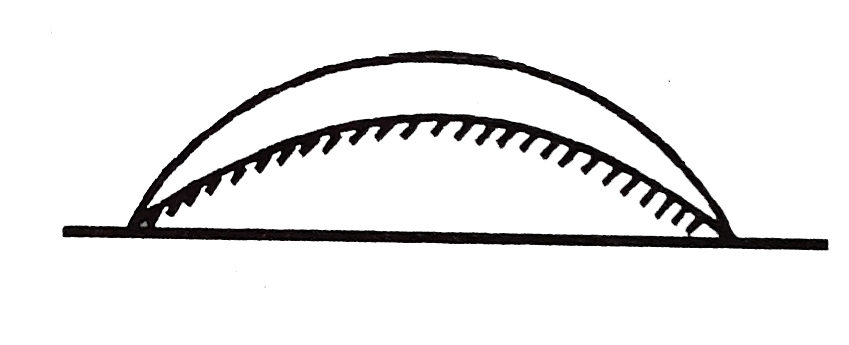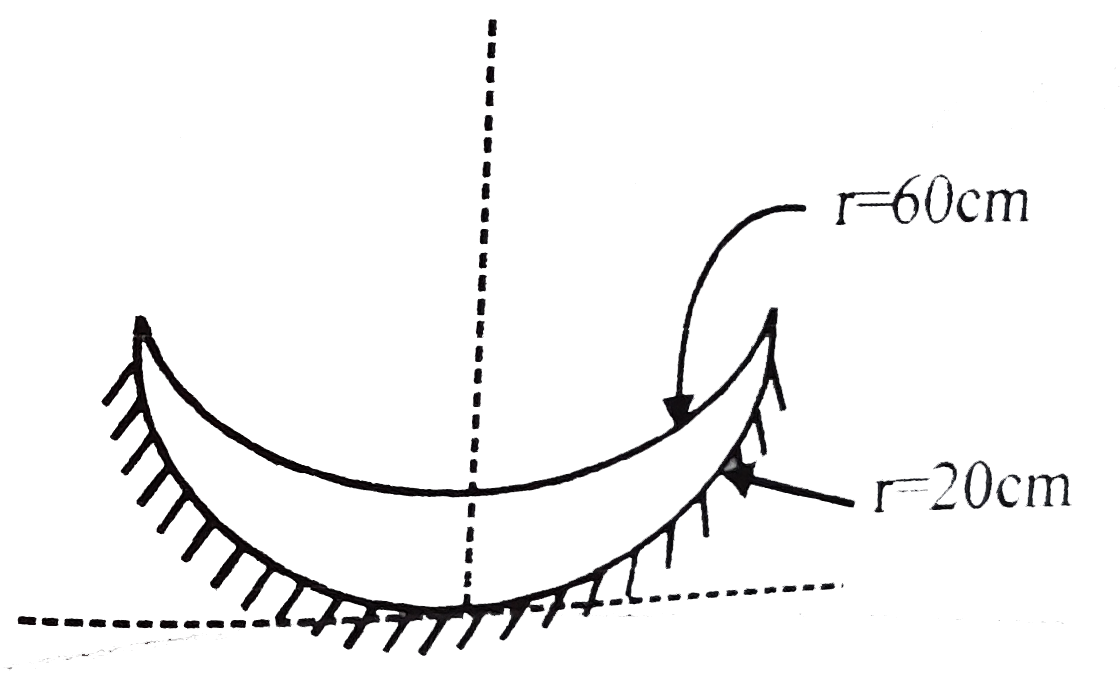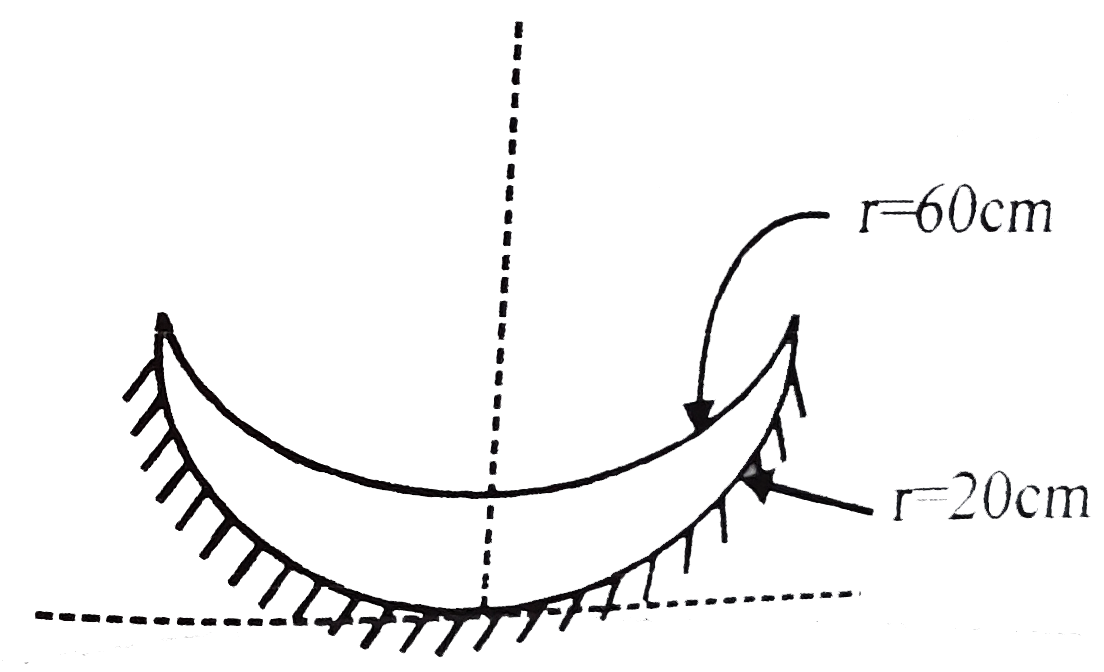A concavo-convex glass (index=1.5) lens has radii of curvatures 60cm and 40cm, respectively. Its convex surface is silvered , and its placed on a horizontal table with concave surface up. The concave surface is then filled with a liquid of index 2.0. The combination behaves like
Concave mirror
Convex mirror
Flat mirror
Convex lens
The correct Answer is:A
To solve the problem step by step, we will analyze the behavior of the concavo-convex lens when its convex surface is silvered and filled with a liquid of a certain refractive index.
Step 1: Identify the Lens and its Properties
We have a concavo-convex lens made of glass with a refractive index (n_glass) of 1.5. The radii of curvature are given as:
- R1 (convex surface) = +60 cm (positive for convex)
- R2 (concave surface) = -40 cm (negative for concave)
Step 2: Determine the Focal Length of the Lens
The focal length (f) of a lens can be calculated using the lens maker's formula:
1f=(n−1)(1R1−1R2)
Substituting the values:
1f=(1.5−1)(160−1−40)
Calculating the right side:
1f=0.5(160+140)
Finding a common denominator (120):
160=2120,140=3120
So,
1f=0.5(2+3120)=0.5(5120)=5240=148
Thus, the focal length f is:
f=48 cm
Step 3: Analyze the Silvered Surface
The convex surface of the lens is silvered, which means it acts as a concave mirror. The focal length of a concave mirror is given by:
fmirror=−R2
For the convex surface (acting as a concave mirror):
fmirror=−602=−30 cm
Step 4: Determine the Effective Focal Length
When the lens is placed on a horizontal table with the concave surface filled with a liquid of refractive index nliquid=2.0, we need to find the effective focal length of the combination (lens + mirror). The effective focal length feffective can be calculated using:
1feffective=1flens+1fmirror
Substituting the values:
1feffective=148+1−30
Finding a common denominator (240):
148=5240,1−30=−8240
Thus,
1feffective=5−8240=−3240=−180
So, the effective focal length is:
feffective=−80 cm
Step 5: Conclusion
The negative effective focal length indicates that the combination behaves like a concave mirror.
We have a concavo-convex lens made of glass with a refractive index (n_glass) of 1.5. The radii of curvature are given as:
- R1 (convex surface) = +60 cm (positive for convex)
- R2 (concave surface) = -40 cm (negative for concave)
The focal length (f) of a lens can be calculated using the lens maker's formula:
1f=(n−1)(1R1−1R2)
Substituting the values:
1f=(1.5−1)(160−1−40)
Calculating the right side:
1f=0.5(160+140)
Finding a common denominator (120):
160=2120,140=3120
So,
1f=0.5(2+3120)=0.5(5120)=5240=148
Thus, the focal length f is:
f=48 cm
The convex surface of the lens is silvered, which means it acts as a concave mirror. The focal length of a concave mirror is given by:
fmirror=−R2
For the convex surface (acting as a concave mirror):
fmirror=−602=−30 cm
When the lens is placed on a horizontal table with the concave surface filled with a liquid of refractive index nliquid=2.0, we need to find the effective focal length of the combination (lens + mirror). The effective focal length feffective can be calculated using:
1feffective=1flens+1fmirror
Substituting the values:
1feffective=148+1−30
Finding a common denominator (240):
148=5240,1−30=−8240
Thus,
1feffective=5−8240=−3240=−180
So, the effective focal length is:
feffective=−80 cm
The negative effective focal length indicates that the combination behaves like a concave mirror.
Topper's Solved these Questions
- BOOK - RESNICK AND HALLIDAYCHAPTER - GEOMETRICAL OPTICS : REFRACTIONEXERCISE - Practice questions(More than one correct choice type)14videos
GEOMETRICAL OPTICS : REFRACTION
- BOOK - RESNICK AND HALLIDAYCHAPTER - GEOMETRICAL OPTICS : REFRACTIONEXERCISE - Practice questions(Linked Comprehension)2videos
GEOMETRICAL OPTICS : REFRACTION
- BOOK - RESNICK AND HALLIDAYCHAPTER - GEOMETRICAL OPTICS : REFRACTIONEXERCISE - Problems44videos
GEOMETRICAL OPTICS : REFRACTION
- BOOK - RESNICK AND HALLIDAYCHAPTER - GEOMETRICAL OPTICS : REFLECTION EXERCISE - PRACTICE QUESTIONS (Integer Type)3videos
GEOMETRICAL OPTICS : REFLECTION
- BOOK - RESNICK AND HALLIDAYCHAPTER - GRAVITATIONEXERCISE - PRACTICE QUESTIONS (INTEGER TYPE)4videos
GRAVITATION
Similar Questions
Two plano concave lenses of glass of refractive index 1.5 have radii of currature 20cm and 30cm respectively.They are placed in contact with the curved surface to wards each other and the space between them is filled with a liquid of refractive index 52. The focal length of the combination is (in cm)
View SolutionThe convex side of a thin concavo-convex lens of glass of refractive index 1.5 has a radius of curvature of 20cm. The concave surface has a radius of curvature of 60cm. What is the focal length of the lens? The convex side is silvered and placed on a horizontal surface. What is the effective focal length of the silvered lens? The concave part is filled with water with refractive index 1.33. What is the effective focal length of the combined glass and water lens? If the convex side is silvered what is the new effective focal length of the silvered compound lens?
View Solution
Knowledge Check
- Question 1 - Select One
The concave surface of a thin concavo-convex lens of index1.5has radius of curvature 50cm and10cm respectively.The concave side is silvered andplaced on a horizontal surface as shown

Focal length of silvered lens is:A30cmB25cmC15cmD10cm - Question 2 - Select One
The concave surface of a thin concavo-convex lens of index1.5has radius of curvature 50cm and10cm respectively.The concave side is silvered andplaced on a horizontal surface as shown

Focal length of lens(without silvered)is:A25cmB20cmC10cmD5cm - Question 3 - Select One
The concave surface of a thin concavo-convex lens of index1.5has radius of curvature 50cm and10cm respectively.The concave side is silvered andplaced on a horizontal surface as shown

The object distance at which its image coincides with itself isA50cmB60cmC30cmD20cm
The convex surface of a thin concave-convex lens of glass of refractive index 1.5 has a radius of curvature 20 cm. The concave surface has a radius of curvature 60 cm. The convex side is silvered and placed on a horizontal surface as shown in figure. (a) Where should a pin be placed on the axis so that its image is formed at the same place ? (b) If the concave part is filled with water (mu = 4/3), find the distance through which the pin should be moved so that the image of the pin again coincides with the pin.
 View Solution
View SolutionThe concave surface of a thin concavo -convex lens of glass of refractive index1.5has a radius of curvature of 20cm.The concave surface has a radius of curvature of 60cm.The covnex side is silvered and placed on a horizontal surface as shown in the figure.

The combination behaves likeView SolutionA convex lens of radii of curvature 20cm and 30 cm respectively. It is silvered at the surface which has smaller radius of curvature. Then it will behave as (μg=1.5)
View SolutionThe concave surface of a thin concavo -convex lens of glass of refractive index1.5has a radius of curvature of 20cm.The concave surface has a radius of curvature of 60cm.The covnex side is silvered and placed on a horizontal surface as shown in the figure.

The focal length of the combibnation has the magnitude.View SolutionA concavo-convex lens has refractive index 1.5 and the radii of curvature of its surfaces are 10cmand20cm. The concave surface is upwards and is filled with oil of refractive index 1.6. The focal length of the combination will be
View Solution

